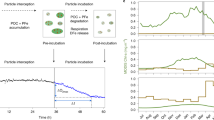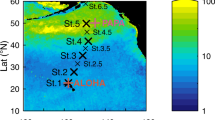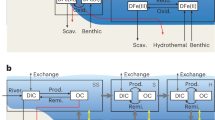Abstract
The production of organic carbon in the ocean’s surface and its subsequent downward export transfers carbon dioxide to the deep ocean. This CO2 drawdown is countered by the biological precipitation of carbonate, followed by sinking of particulate inorganic carbon, which is a source of carbon dioxide to the surface ocean, and hence the atmosphere over 100–1,000 year timescales1. The net transfer of CO2 to the deep ocean is therefore dependent on the relative amount of organic and inorganic carbon in sinking particles2. In the Southern Ocean, iron fertilization has been shown to increase the export of organic carbon3,4,5, but it is unclear to what degree this effect is compensated by the export of inorganic carbon. Here we assess the composition of sinking particles collected from sediment traps located in the Polar Frontal Zone of the Southern Ocean. We find that in high-nutrient, low-chlorophyll regions that are characterized by naturally high iron concentrations, fluxes of both organic and inorganic carbon are higher than in regions with no iron fertilization. However, the excess flux of inorganic carbon is greater than that of organic carbon. We estimate that the production and flux of carbonate in naturally iron-fertilized waters reduces the overall amount of CO2 transferred to the deep ocean by 6–32%, compared to 1–4% at the non-fertilized site. We suggest that an increased export of organic carbon, stimulated by iron availability in the glacial sub-Antarctic oceans, may have been accompanied by a strengthened carbonate counter pump.
This is a preview of subscription content, access via your institution
Access options
Subscribe to this journal
Receive 12 print issues and online access
$259.00 per year
only $21.58 per issue
Buy this article
- Purchase on Springer Link
- Instant access to full article PDF
Prices may be subject to local taxes which are calculated during checkout



Similar content being viewed by others
References
Zeebe, R. E. History of seawater carbonate chemistry, atmospheric CO2, and ocean acidification. Annu. Rev. Earth Planet. Sci. 40, 141–165 (2012).
Antia, A. N. et al. Basin-wide particulate carbon flux in the Atlantic Ocean: Regional export patterns and potential for atmospheric CO2 sequestration. Glob. Biogeochem. Cycles 15, 845–862 (2001).
Pollard, R. T. et al. Southern Ocean deep-water carbon export enhanced by natural iron fertilization. Nature 457, 577–580 (2009).
Salter, I. et al. Diatom resting spore ecology drives enhanced carbon export from a naturally iron-fertilized bloom in the Southern Ocean. Glob. Biogeochem. Cycles 26, GB1014 (2012).
Smetacek, V. et al. Deep carbon export from a Southern Ocean iron-fertilized diatom bloom. Nature 487, 313–319 (2012).
Volk, T. & Hoffert, M. I. in The Carbon Cycle and Atmospheric CO2: Natural Variations Arcana to Present Vol. 32 (eds Sunquist, E. T. & Broeker, W. S.) 99–111 (Geophys. Monogr. Series, American Geophysical Union, 1985).
Sigman, D. M. & Boyle, E. A. Glacial/interglacial variations in atmospheric carbon dioxide. Nature 407, 859–869 (2000).
Martin, J. H. Glacial-interglacial CO2 change: The iron hypothesis. Paleoceanography 5, 1–13 (1990).
Heinze, C., Maier-Reimer, E. & Winn, K. Glacial pCO2 reduction by the world ocean: Experiments with the Hamburg carbon cycle model. Paleoceanography 6, 395–430 (1991).
Frankingnoulle, M., Canon, C. & Gattuso, J. P. Marine calcification as a source of carbon dioxide: Positive feedback of increasing atmospheric CO2 . Limnol. Oceanogr. 39, 458–462 (1994).
King, A. L. & Howard, W. R. ∂18O seasonality of planktonic foraminifera from Southern Ocean sediment traps: Latitudinal gradients and implications for paleoclimate reconstructions. Mar. Micropaleontol. 56, 1–24 (2005).
Howard, W. R. et al. Distribution, abundance and seasonal flux of pteropods in the Sub-Antarctic Zone. Deep-Sea Res. II 58, 2293–2300 (2011).
Schiebel, R. Planktic foraminiferal sedimentation and the marine calcite budget. Glob. Biogeochem. Cycles 16, 1065 (2002).
Wolff, G. A. et al. The effects of natural iron fertilization on deep sea ecology: The Crozet Plateau, Southern Indian Ocean. PLoS ONE 6, e20697 (2011).
Venables, H. J., Pollard, R. T. & Popova, E. E. Physical conditions controlling the development of a regular phytoplankton bloom north of the Crozet Plateau, Southern Ocean. Deep-Sea Res. II 54, 1949–1965 (2007).
Roberts, D. et al. Interannual pteropod variability in sediment traps deployed above and below the aragonite saturation horizon in the Sub-Antarctic Southern Ocean. Polar Biol. 34, 1739–1750 (2011).
Schiebel, R. et al. Planktic foraminiferal dissolution in the twilight zone. Deep-Sea Res. II 54, 676–686 (2007).
Moy, A. D. et al. Reduced calcification in modern Southern Ocean planktonic foraminifera. Nature Geosci. 2, 276–280 (2009).
Honjo, S. et al. Particle fluxes to the interior of the Southern Ocean in the Western Pacific sector along 170° W. Deep-Sea Res. II 47, 3521–3548 (2000).
Trull, T. et al. Moored sediment trap measurements of carbon export in the Subantarctic and Polar Frontal Zones of the Southern Ocean, south of Australia. J. Geophys. Res. 106, 31489–31509 (2001).
Marsh, R. et al. Controls on sediment geochemistry in the Crozet region. Deep-Sea Res. II 54, 2260–2274 (2007).
Watson, A. J. et al. Effect of iron supply on Southern Ocean CO2 uptake and implications for atmospheric CO2 . Nature 407, 730–733 (2000).
Sigman, D. M. et al. The polar ocean and glacial cycles in atmospheric CO2 concentration. Nature 466, 47–55 (2010).
Robinson, R. S. et al. Diatom-bound 15N/14N: New support for enhanced nutrient consumption in the ice age subantarctic. Paleoceanography 20, PA3003 (2005).
Kohfeld, K. E. et al. Role of marine biology in glacial-interglacial CO2 cycles. Science 308, 74–78 (2005).
Mahowald, N. M. et al. Change in atmospheric mineral aerosols in response to climate: Last glacial period, preindustrial, modern and doubled carbon dioxide climates. J. Geophys. Res. 111, D10202 (2006).
Martínez-Garcia, A. et al. Iron fertilization of the Subantarctic Ocean during the last ice age. Science 343, 1347–1350 (2014).
Bé, A. W. H. & Hutson, W. H. Ecology of planktonic foraminifer and biogeographic patterns of life and fossil assemblages in the Indian Ocean. Micropaleontology 23, 369–414 (1977).
Bakker, D. C. et al. The island mass effect and biological carbon uptake for the subantarctic Crozet Archipelago. Deep-Sea Res. II 54, 2174–2190 (2007).
Buesseler, K. O. et al. Revisiting carbon flux through the ocean’s twilight zone. Science 316, 567–570 (2005).
Orsi, A. H. et al. On the meridional extent and fronts of the Antarctic Circumpolar Current. Deep-Sea Res. I 42, 641–673 (1995).
Moore, J. K. et al. Location and dynamics of the Antarctic polar front from satellite sea surface temperature data. J. Geophys. Res. 104, 3059–3073 (1999).
Sallée, J. B. et al. Southern Ocean fronts and their variability to climate modes. J. Clim. 12, 3020–3039 (2008).
Acknowledgements
Sediment trap deployments were funded through the NERC programmes CROZeX (PI: Pollard, R.T) and Benthic Crozet (PI: Wolff, G.A.). P.Z. was funded through the projects CGL2009-10806 (MinECo) and 265103 (EC-FP7). We are grateful to the captain and crew of R.R.S. Discovery for their support throughout the cruises D285, D286 and D300. We thank D. Bakker for sharing published DIC and TA data, calculating omega values and her detailed comments. M. Rembauville assisted in the preparation of Fig. 3. We are also grateful to M. C. Nielsdóttir and S. Blain for commenting on earlier versions of the manuscript. Finally we acknowledge the scientific participants of the CROZeX and Benthic Crozet programmes.
Author information
Authors and Affiliations
Contributions
I.S. formulated the idea and together with R.S. designed the analytical approach. I.S. wrote the manuscript with all co-authors commenting. I.S. and R.S. performed all preparation and classification measurements on the foraminifer and pteropod fractions. A.M. measured calcite and aragonite mass of individual tests and R.S. and I.S. synthesized data. P.Z. performed ICP-AES measurements on the fine fraction. I.S. performed all bulk chemical analyses. G.W. and R.L. provided access to the sediment trap samples collected during the Benthic Crozet and CROZeX research programmes, respectively. All co-authors contributed to the manuscript.
Corresponding author
Ethics declarations
Competing interests
The authors declare no competing financial interests.
Supplementary information
Supplementary Information
Supplementary Information (PDF 7805 kb)
Rights and permissions
About this article
Cite this article
Salter, I., Schiebel, R., Ziveri, P. et al. Carbonate counter pump stimulated by natural iron fertilization in the Polar Frontal Zone. Nature Geosci 7, 885–889 (2014). https://doi.org/10.1038/ngeo2285
Received:
Accepted:
Published:
Issue Date:
DOI: https://doi.org/10.1038/ngeo2285
This article is cited by
-
Pelagic calcium carbonate production and shallow dissolution in the North Pacific Ocean
Nature Communications (2023)
-
The FORCIS database: A global census of planktonic Foraminifera from ocean waters
Scientific Data (2023)
-
Calcification of planktonic foraminifer Neogloboquadrina pachyderma (sinistral) controlled by seawater temperature rather than ocean acidification in the Antarctic Zone of modern Sothern Ocean
Science China Earth Sciences (2022)
-
Exceptionally high biosphere productivity at the beginning of Marine Isotopic Stage 11
Nature Communications (2020)
-
Threatened species drive the strength of the carbonate pump in the northern Scotia Sea
Nature Communications (2018)



